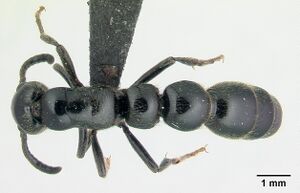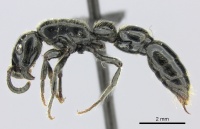Simopone victrix
| Simopone victrix | |
|---|---|

| |
| Scientific classification | |
| Kingdom: | Animalia |
| Phylum: | Arthropoda |
| Class: | Insecta |
| Order: | Hymenoptera |
| Family: | Formicidae |
| Subfamily: | Dorylinae |
| Genus: | Simopone |
| Species group: | emeryi |
| Species: | S. victrix |
| Binomial name | |
| Simopone victrix Bolton & Fisher, 2012 | |
Specimens have been collected from low vegetation, a rotten log, and as ground foragers from montane rainforest and rainforest habitats.
Identification
A member of the emeryi species group. Of the five species in the silens complex victrix is quickly diagnosed by dense punctate sculpture on the tergites of AV and AVI. Also see the identification section under Simopone rex. (Bolton and Fisher 2012)
Keys including this Species
Distribution
Latitudinal Distribution Pattern
Latitudinal Range: -12.51391° to -13.96833333°.
| North Temperate |
North Subtropical |
Tropical | South Subtropical |
South Temperate |
- Source: AntMaps
Distribution based on Regional Taxon Lists
Malagasy Region: Madagascar (type locality).
Distribution based on AntMaps
Distribution based on AntWeb specimens
Check data from AntWeb
Countries Occupied
| Number of countries occupied by this species based on AntWiki Regional Taxon Lists. In general, fewer countries occupied indicates a narrower range, while more countries indicates a more widespread species. |

|
Estimated Abundance
| Relative abundance based on number of AntMaps records per species (this species within the purple bar). Fewer records (to the left) indicates a less abundant/encountered species while more records (to the right) indicates more abundant/encountered species. |

|
Biology
|
Castes
Worker
Images from AntWeb
   
| |
| Paratype of Simopone victrix. Worker. Specimen code casent0134495. Photographer Erin Prado, uploaded by California Academy of Sciences. | Owned by CAS, San Francisco, CA, USA. |
Nomenclature
The following information is derived from Barry Bolton's Online Catalogue of the Ants of the World.
- victrix. Simopone victrix Bolton & Fisher, 2012: 68, figs. 76-78 (w.) MADAGASCAR.
- Type-material: holotype worker, 4 paratype workers.
- Type-locality: holotype Madagascar: Prov. Antsiranana, R.S. Manongarivo, 12.8 km. 228° SW Antanambao, 780 m., 13°58.6’S, 48°25.4’E, 11-17.x.1988, BLF1898, CASENT0004512, on low vegetation, rainforest (B.L. Fisher); paratypes: 1 worker Montagne d’Ambre, 12.52574°S, 49.17238°E, 15.xi.2007, 1025 m., BLF18341, CASENT0134168, montane rainforest (B.L. Fisher), 1 worker with same locality but 12.58132°S, 49.13368°E, 13.xi.2007, 1110 m., BLF18110, CASENT0134495, montane rainforest (B.L. Fisher), 1 worker with same locality but 12.51391°S, 49.17784°E, 23.ii.-02.iii.2011, 984 m., BLF26057, CASENT0213949 (B.L. Fisher), 1 worker as last but BLF26077, CASENT0213236 (B.L. Fisher).
- Type-depository: CASC.
- Distribution: Madagascar.
Unless otherwise noted the text for the remainder of this section is reported from the publication that includes the original description.
Description
Worker
(holotype in parentheses). HL 1.90–2.00 (1.90), HW 1.49–1.58 (1.49), SL 0.62–0.70 (0.62), EL 0.49–0.50 (0.49), PW 1.18–1.30 (1.18), AIIW 1.18–1.34 (1.18), AIIL 0.95–1.04 (1.04), AIIIW 1.40–1.52 (1.40), AIIIL 1.24–1.36 (1.32), WL 2.40–2.42 (2.40), MFL 1.45–1.48 (1.45), CI 78–79 (78), SI 42–44 (42), EL/HW 0.32–0.33 (0.33), EP 1.21–1.29 (1.29), AIIW/AIIL 1.14–1.30 (1.14), AIIIW/AIIIL 1.06–1.16 (1.06) (5 measured).
In full-face view anteriormost points of frontal lobes are slightly posterior to the level of the midpoint of the shallowly convex anterior clypeal margin. With head tilted slightly back from full-face view the clypeal margin in front of each antennal socket is convex and projects slightly farther forward than the midpoint of the anterior clypeal margin. Frontal carinae are distinctly divergent posteriorly and extend back to the level of the anterior margins of the eyes, or very nearly so. Eyes located behind the cephalic midlength (EP 1.21–1.29). Leading edge of scape with conspicuous projecting setae. In full-face view entire side of head with setae that are curved anteriorly. In profile entire dorsum of head, and ventral surface, with curved standing setae that are short and fine. Cephalic dorsum between eyes with numerous minute punctures and also with larger but sparse foveolate punctures, on a glossy surface. Anterior and dorsal surfaces of pronotum separated by an angle or weak margination, but without a strongly defined carina. Propodeal dorsum meets declivity through a blunt angle, without a transverse carina. Propodeal declivity finely densely punctulate. Promesonotal suture weakly impressed and without a series of ribs or aligned coarse punctures; metanotal groove vestigial to absent but median pit conspicuous. Mesosoma in dorsal view narrower across mesonotum than pronotum, broadest across propodeum (in holotype PW 1.18, width across mesonotum at its midlength 1.08, maximum width across propodeum 1.22). Dorsum of mesosoma with numerous small to minute punctures. Entire mesosoma dorsally with numerous short, fine, curved setae that are suberect to subdecumbent and longer on the anterior pronotum and posterior propodeum than in the intervening part of the dorsum. Dorsal (outer) surfaces of mesotibiae and metatibiae with standing setae present that are curved or inclined toward the apex. Dorsal surface of AII (petiole) meets anterior surface at an angle, without a transverse carina. Posteriorly the dorsum of AII lacks a carina but a weak transverse ridge is usually present above the foramen. In dorsal view the posterior corners of AII either form sharp angles or small triangular teeth that project laterally. Lateral surface of AII, below the dorsolateral margin and above the level of the spiracle, without a longitudinal ridge or carina that extends the length of the sclerite. In dorsal view AII, AIII and AIV all distinctly broader than long. Abdominal tergites AII to AIV with numerous curved setae that are directed posteriorly and are mostly suberect to subdecumbent. Curved setae numerous and distinct on sternites of AIII and AIV. Abdominal tergites AII to AIV sculptured only with numerous small punctures, sparsest on AII; tergites of AV and AVI also evenly densely covered with small punctures. Full adult colour black, appendages blackish brown to black; clypeus with or without a dull reddish tint; sides of pronotum and sides of abdominal tergites AIII and AIV without dull red spots in known material.
Type Material
Holotype worker, Madagascar: Prov. Antsiranana, R.S. Manongarivo, 12.8 km 228° SW Antanambao, 780 m, 13°58.6’S, 48°25.4’E, 11-17.x.1998, BLF1898, CASENT0004512, on low vegetation, rainforest (B.L. Fisher) (California Academy of Sciences). Paratypes. 1 worker, Madagascar: PN Montagne d’Ambre, 12.52574°S, 49.17238°E, 15.xi.2007, 1025 m, BLF18341, CASENT0134168, montane rainforest (B.L. Fisher); 1 worker with same locality data but 12.58132°S, 49.13368°E, 13.xi.2007, 1110 m, BLF18110, CASENT0134495, montane rainforest (B.L. Fisher); 1 worker with same locality data but 12.51391°S, 49.17784°E, 23.ii.-02.iii.2011, 984 m, BLF26057, CASENT0213949, 1 worker with same data as the previous specimen but BLF26077, CASENT0213236 (CASC).
References
- Bolton, B. & Fisher, B.L. 2012. Taxonomy of the cerapachyine ant genera Simopone Forel, Vicinopone gen. n. and Tanipone gen. n. (Hymenoptera: Formicidae). Zootaxa 3283, 1–101 (doi:10.11646/zootaxa.3283.1.1).
References based on Global Ant Biodiversity Informatics
- Bolton B., and B. L. Fisher. 2012. Taxonomy of the cerapachyine ant genera Simopone Forel, Vicinopone gen. n. and Tanipone gen. n. (Hymenoptera: Formicidae). Zootaxa 3283: 1-101.


